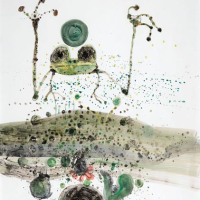27. JOHN OLSEN

An environmental conservationist before it was fashionable, John Olsen was one of Australias first modern artists to draw out the beauty in the minutiae of Australian landscape and ecology. His awakening to Australias astonishing natural diversity came in 1971, through his involvement in the ABCs Wild Australia series. Hired to contribute his creative perceptions of the unique wildlife and landscapes documented, Olsens deft and insightful observations provided a viewpoint previously unavailable to the scientists on the program:
[While] the camera was still waiting for the essential degree KelvinJohn could freeze the dancing leap of the brolgacaricature the gulping pelican chick feeding from its parents maw, and merge a hundred banded stilts into one amorphous protected flock.1
Olsens first interactions with frogs came about while on the set of Wild Australia, and having been instantly gripped by their strangely anthropomorphic quality and compelling physicality, they remain a recurring and important subject in his work.3 [T]he frogis just as important as the eagle or the tiger; every movement is connected to the primary source of life.3 In Olsens handling, the frog becomes a metaphor for the fragile yet irrepressible nature of life itself. Olsen sees in the frog, and wants us to see too, not just the universe, but ourselves, and our relationship to the living world.
Frog in a Pond is a quintessential John Olsen frog painting, both comic and profound. This work draws on Olsens interest in Chinese and Japanese art and Buddhist and Taoist symbols. Olsen has said: The Chinese and the Japanese through the Taoists and Buddhists are just so divinely subtle. They are the first ecologists. Man is an organism related to every living thing.4
Olsens frogs are usually depicted undertaking froglike business: draped over tree branches, eating flies, swimming. Captured leaping towards us, this frog seems burdened with more metaphysical concerns, floating meditatively above the pond like the sage referenced in the Tao Te Ching the sage, because he does nothing, never ruins anything; and because he does not lay hold of anything, loses nothing.5 The flat line of the frogs mouth and black expressionless eyes evoke the inscrutability of mystics. The circle positioned behind the frogs head and reflected in the surface of the pond, is rich with symbolism, referencing the interconnectedness of nature (of which man is a part), the wheel of reincarnation, our Earth and the sun, which generates life itself.
The artist describes this microcosmos with typical restraint and mastery of his medium, using an economy of deliberate brushstrokes similar to Zen brushwork. Unlike the Eastern tradition however6, Olsen chooses the ungainly frog as his subject and allows a hint of chaos to enter his work. The spattering of droplets perfectly recalls the movement of water suddenly displaced, but the very application of these drops necessitating random chance is also a reminder of the disorder inherent in the natural world.
Frog in a Pond is illustrative of Olsens respect for the mystical, observable factor7 found in cave paintings worldwide. What Olsen is referring to is the capacity for art to describe something essential about the nature of nature, or more accurately, how we as humans perceive nature to be. It is nearly impossible for us to look at animals without projecting onto them our own characteristics. Olsens depictions of animals always manage to capture that something essential. Perhaps not always anatomically correct, but always resonating with our feeling of how frogs and birds exist in our world. This is why, tens of thousands of years later, Kimberley rock art paintings are instantly recognisable. It is also why, when we see Frog in a Pond we recognise the frog, the pond, the movement, the whole world.
Footnotes
1. Douglas Dorward quoted in Hart, D., John Olsen, Craftsman House, Sydney 1991, p.126
2. Olsen, J., John Olsen; Drawing The Human Touch with an interview by Ken McGregor, Macmillan Art Publishing Melbourne, Australia, 2014, p.22
3. John Olsen quoted in Hart, D., John Olsen, p.131
4. Ibid.
5. Lao Tzu Tao Te Ching, Penguin Classics, Ringwood, Victoria, Australia, 1996, p.71
6. D.T. Suzuki quoted in Hart, D., John Olsen, p.131
7. John Olsen quoted in Hart, D., John Olsen, p.124
Corinna Cullen BA MA (Art History and Curatorial Studies)